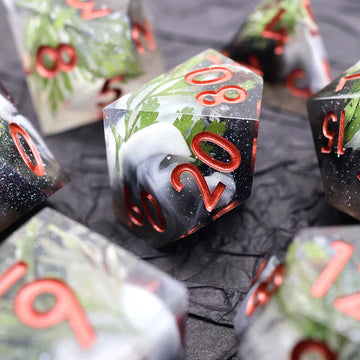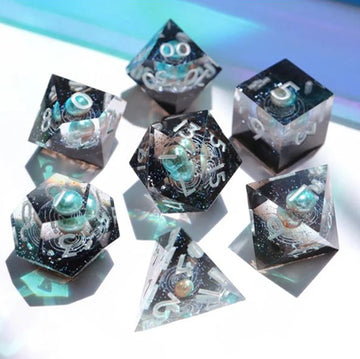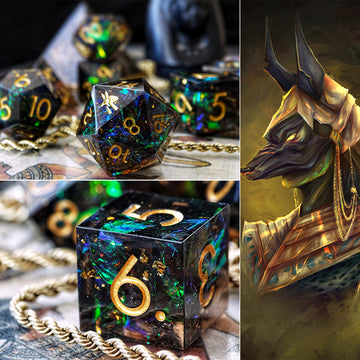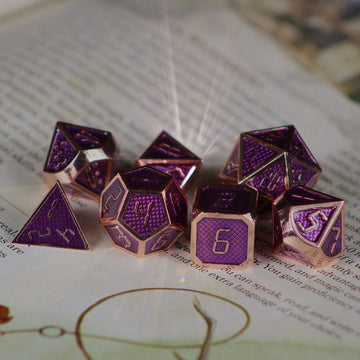Authored by Alexander Atoz
Of all the props in D&D, none are as integral—or as varied—as dice. You can find sets designed to match your class, campaign setting, or even your character's personality.
But once the campaign ends, your character retires, and the story is over... what happens to all those dice?
In this article, we'll explore creative ways to bring extra dice into your sessions. With a little imagination, you can use them to enhance mechanics, heighten tension, and transform your game from great to unforgettable.
Villain Power Dice
Not all enemies are equal. At some point in every campaign, the endless mobs give way to a truly dangerous foe.
You'll distinguish this villain with vivid description and stronger stats—but a visible prop makes the moment even more dramatic. Miniatures can help, but not always. A lich miniature just looks like a basic skeleton wearing a cloak, and few players can tell the difference between the CR 20 pit fiend and a CR 5 hill giant at a glance.
The solution? Special dice for serious enemies—or better yet, for their most devastating attacks. Tell your players: "This monster uses special fire/poison/death dice." Then back it up with real consequences by attaching a special effect to those rolls.
Ideas for Villain Power Dice
- Extra Damage: Let the dice deal double damage. This doesn't require changing the actual rules, just pretending to. For example, if the attack normally deals 4d6, roll 2d6 and double the result. It keeps the math simple and doesn't draw attention to itself—perfect for attacks that are already dangerous.
- Debuffs and Conditions: Tie a special die to effects like poison, stun, or paralysis. Start with one condition, and expand gradually so players learn to associate specific dice with specific threats.
- Other Effects: Use dice rolls to trigger unique powers—teleportation, sudden armor boosts, or similar abilities. Set the rules so that they take place right after an attack roll. Have the roll double as the trigger, keeping things fast and dramatic.
The first few times, your players may not think much of it. But over time they'll start to recognize that those dice mean trouble. When you roll them for an ambush, they won't need to see the enemy who's attacking to know that they're in trouble. The dice alone will set the mood.
For this to work, roll openly. Public rolls reassure players you aren't cheating and make enemy actions feel weightier. Save your "cheating" for subtle adjustments behind the scenes, like tweaking the next encounter. Letting players believe they won fairly is one of the best rewards you can give them.
Player Bonuses
Many characters have special abilities that come with limited uses. A few—like the bard's Bardic Inspiration, the battlemaster's Superiority Dice, and the upcoming psion's Psi Dice—already use dice directly. Giving players a physical pool of dice makes those abilities easier to track and more satisfying to use in the heat of battle.
Abilities That Don't Fit as Well
You could use dice to represent the barbarian's rages or the monk's focus points, but those don't translate neatly. Rage usually lasts an entire combat, and monks often spend multiple points in a single turn. Dice feel clunky in those cases. This leads us into the other form of player dice bonuses: Magical items.
Magic Items with Dice Mechanics
When tying dice to magical items, look for effects that naturally involve rolling:
Part I: Items Using d20
- Success Rolls: Some items could give a boost on d20 rolls—granting advantage to certain ability checks, such as saving throws or charisma checks. These items reinforce the core "pass/fail" mechanic. Showcase them by giving your players "special" dice to use when they want to have the bonuses attached.
-
Activation Rolls: Other items might require a d20 roll just to see if their power activates, keeping the outcome uncertain and suspenseful.
Part II: Items Using Other Dice
- Damage Boosts: A weapon might roll an extra die of fire or poison damage. On a high roll, the effect could escalate—blinding or poisoning the target for a round.
- Healing Increases: A restorative item could improve healing by the rolled amount, or even double it.
- Mobility Effects: Boots, cloaks, or talismans could grant movement or teleportation equal to the roll x5 feet.
This approach keeps abilities both visible and exciting. The dice themselves become part of the story, turning item use into a small event instead of a line on a character sheet.
Value as a Reminder
Not only does this make abilities more visible, it also serves as a physical reminder that the option is available—reducing those moments when a player rolls and only afterward remembers they had a special ability to use.
You might consider giving each player a single "mulligan" to redo a roll, then ruling that all other actions are locked in once taken. But know your table: if a rule frustrates or discourages your players, it's rarely worth enforcing.
Dice as a Timer
Dice can also be used to mark the passage of time. This technique works best when you want to keep the action moving and prevent players from lingering too long. Take a die, set it to the highest number, then after a few seconds move it down one number, and repeat.
"You have 12 seconds left. Now 11. 10... 9..."
A DM I admire enforces this by only allowing table chatter before combat begins—once combat starts, anyone who talks too long loses their turn. It keeps the pacing sharp and the tension high.
Best Places for a Timer
This technique works okay when you want to keep the action moving and prevent players from lingering too long, but is most effective in especially climactic moments—such as navigating a complex trap or escaping a collapsing chamber. The visible countdown adds urgency and drama. For more mundane hurrying up players, a stopwatch or a sand timer is often better.
Whatever your situation is, make sure you provided all the information needed before starting the time. To do otherwise is plain unfair.
Advantages of a Dice Timer
Using dice as a timer provides a visible reminder of time passing. It's less intrusive than the DM constantly announcing how much time is left, and it allows you to keep up NPC dialogue without distraction.
As an added bonus, if you have dice in different colors, you can swap them out every few "ticks"—green to blue to red—so the players see their time dwindling more clearly. This visual escalation keeps tension high without you needing to say a word.
Using the Timer Properly
When using dice as a timer, keep the countdown moving. Don't make each "tick" drag on for long stretches; it's better to tighten the clock near the end than to start too slowly and give away too much time. And when the countdown runs out, stand firm. A good DM works with their players, but still needs the authority to say, "Time's up."
Time Until Excitement
Dice timers don't have to represent the players time running out—they can also measure the time until something big happens. For example, while investigating a location, the party might have a set number of turns before the villain arrives. They might know how long they have, or they might not, in which case the time will count upwards.
The idea is to give them time to explore, while letting them know that the action is coming.
Without limits, intermission scenes often drag. Players hesitate to move on, worried they'll miss something important. But when the dice make it clear that time is running, the story keeps its momentum. A good game thrives on pacing, and visible timers help you keep things moving.
Counting Down to Victory
Some challenges aren't about fighting monsters—they're about wearing down obstacles. Think of breaking through a wall, digging a tunnel, or forcing open a heavy door. These kinds of plot points can require multiple successes to complete, and dice are a great way to track progress.
Of course, these obstacles shouldn't exist in isolation. If nothing else is happening, you might as well let the players succeed automatically instead of rolling for every swing of a pickaxe. Where the dice shine is when the barrier is paired with outside pressure—enemies closing in, traps activating, or time running out. Suddenly, every tick of progress matters.
Fair Division of Labor
Be careful not to design these challenging so that one character is stuck doing all the grunt work while everyone else enjoys the action. There are a couple of ways to balance this:
- NPC as Worker: Let an NPC handle the digging, breaking, or other repetitive task. In this case, the dice simply act as a timer, counting down rounds until success.
- Shared Responsibility: Require each player to contribute. Hand out dice to represent their progress, and have them place a die in a designated spot once they fulfill their part of the task. This way, everyone stays engaged.
Both methods keep the spotlight balanced while still making progress visible through dice.
Extra Rules
Some RPGs use dice in ways that D&D does not. While you probably wouldn't want to make a permanent change to D&D's rules, you can borrow these mechanics temporarily—by tying them to a magical item or a curse—for a fresh twist.
A magic item will let the players choose when to invoke the extra effect. A curse will tie it to a location or monster. I like the magic item better, but you'll have to decide your own preference.
Boons and Banes
In Dungeon World and Shadow of the Demon Lord, dice rolls can produce extra benefits or setbacks depending on the results. D&D already does this with natural 20s, but you can push it further with special dice to occasionally trigger a great boon or bane, irrespective of the main roll:
- Extra Failure: A low roll right might trigger an additional complication beyond just "miss." If the main dice succeeded, sometimes we don't succeed in the way we hoped.
- Extra Success: DMs often have trouble with this one. For example: What is an extra successful persuasion check? One solution would be to have a high roll restore resources expanded in the attempt. I.E. rages, focus points, spell slots, or even HP.
- Pairing the Two Together: The problem with my extra success reward is that it isn't the opposite of the failure condition. Some DMs won't mind. If you do mind, let the players spend resources to avert the disaster. If you priced this right, they won't do it. You can also let them suggest a non-resource reward when winning a boon, subject to your approval. They won't do this either, but now the two are the same.
Push Your Luck (inspired by Exalted and similar systems)
Some games include mechanics where players can spend energy to roll extra dice, gaining bigger bonuses but also bigger risks. in Exalted, for example, characters can burn motes of Essence to supercharge a roll—sometimes rolling so high that the outcome backfires dramatically.
You can adapt this as a push-your-luck magic item in D&D:
- The item lets a player attempt something normally impossible—divining the location of a plot device, teleporting across great distances, or tunneling straight into an enemy fortress.
- The player can or must spend resources (HP, spell slots, exhaustion, etc.), with more resources meaning more extra dice, booting their chances or reward.
- But if the total goes over a set threshold, they don't just fail—they loose everything they risked and more.
This creates tense, memorable moments where players weigh whether the potential gain is worth the danger—and you, as DM, get to improvise the fallout.
Momentum Dice (inspired by Conan 2d20)
Another system to borrow from is Conan's Momentum mechanic, where good rolls generate points that can be spent later. You can adapt this with a magic item that grants Momentum dice:
- Earning Momentum: Players gain a Momentum die when they roll especially well or fulfill certain conditions.
- Spending Momentum: A Momentum die can be spent to trigger a special ability, but if they roll too low they risk dangerous backlash. The longer they hold onto it, the higher the target number they have to hit when they finally roll it.
- Backlash on Delay: To avoid the frustration of wasted rewards, have the ability still activate on a failed roll—but a backlash effect costs the player HP or causes another penalty.
The Flip Side: A Curse
Instead of granting power, the same mechanic can drive tension through a curse:
- The player characters are cursed. If the curse isn't dealt with quickly, probably by fulfilling a certain condition, the DM rolls a die at fixed internals.
- A low roll triggers damage or penalties, while a high roll means they survive another tick.
- To build suspense, the target number can creep upward over time. Use a d20—or at least a d12—so the range feels dangerous without being predictable, and so they have a little time.
This design keeps pressure high, either by tempting players to use a reward before it sours, or by forcing them to race against a curse that could strike at any time.
This post was written by Alexander Atoz. Alexander Atoz is the author of dragonencounters.com, a site giving unique advice on creating situations to get the most out of each monster. Alexander handles each monster in turn, making the most basic monster fun, and the most complex monster playable. Includes easy ideas that will fit well into any campaign and unique ideas for each of the forty dragons in D&D.







